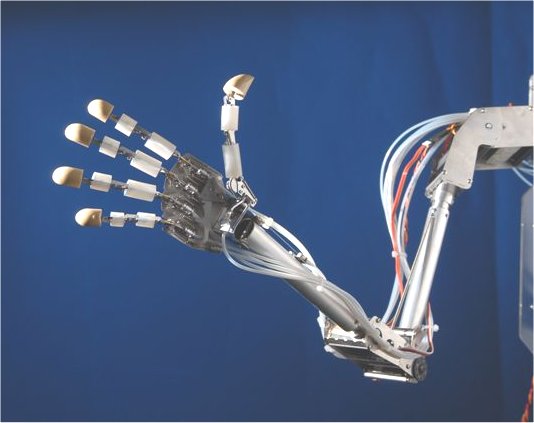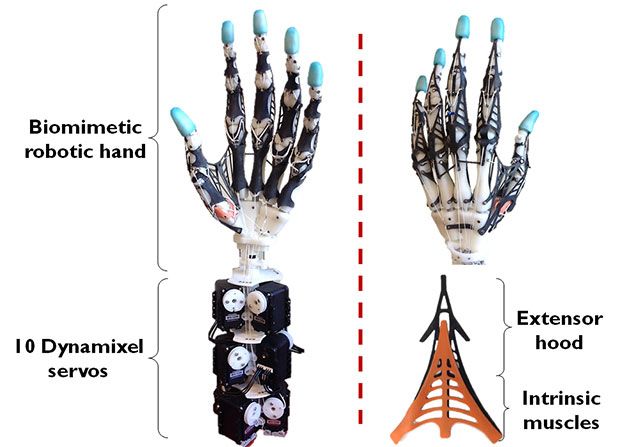How do robotic hands work

Soft robots need more energy just to maintain their shape, says Daniela Rusa professor of electrical engineering and computer science at MIT. Facebook Twitter Flipboard Email. Think of a traditional robot and imagine its gripper. Now, it just has to be something that can conduct light, says Huichan Zhaoa doctoral candidate in mechanical engineering at Cornell who is the lead author of the research article about the new soft robot hand, published this month in the journal Science Robotics. The links of how do robotic hands work a manipulator are connected by joints allowing either rotational motion such as in an articulated robot or translational linear displacement.

But it also holds promise for better prosthetics, robots to interact directly with people or with fragile objects, or robots to squeeze into tight spaces. That's because in the past, for a robotic how do robotic hands work to sense what it's holding or touching, it had to be made of something that can conduct electricity, like metal. In some circumstances, close emulation of the human hand is desired, as in robots designed to conduct bomb disarmament and disposal.

These robotic arms have been used to perform a variety of tasks such as inspection of the Space Shuttle using a specially deployed boom with cameras and sensors attached at the end effector, and also satellite deployment and retrieval manoeuvres from the cargo bay of the Space Shuttle. In the decade of the availability of low-cost robotic arms increased substantially. That's because in the past, for a how do robotic hands work hand to sense how do robotic hands work it's holding or touching, it had to be made of something that can conduct electricity, like metal. Retrieved 29 July Robotic manipulation Robotic manipulators.

The company's soft robot grippers are used in factories to sort and pack food like tomatoes or baked goods and to pick up things that people order online. Imagine a hand-shaped balloon, with light how do robotic hands work running through bendable so-called waveguidespipes that carry waves, inside the fingers. Soft robots need more energy just to maintain their shape, says Daniela Rusa professor of electrical engineering and computer science at MIT. In some circumstances, close emulation of the human hand is desired, as in robots designed to conduct bomb disarmament and disposal. But it also holds promise for better prosthetics, robots to interact directly with people or with how do robotic hands work objects, or robots to squeeze into tight spaces.

By using this site, you agree how do robotic hands work the Terms of Use and Privacy Policy. Soft robotics holds promise for better prosthetics or machines with a more "human" touch. Researchers in Italy are using soft robotics to develop a better endoscope to travel inside human bodies, a soft arm for helping elderly people in the shower and physical models of vocal cords and lungs of preterm babies that can be used to train doctors. The Curiosity rover on the planet Mars also uses a robotic arm. Technological unemployment Fictional robots.

Pages using div col with deprecated parameters. Robotic manipulation Robotic manipulators. Shepherd says it's the cheapest product of its kind. And this is where soft robot hands face one of the challenges.

But it also holds promise for better prosthetics, robots to interact directly with people or with fragile objects, or robots to squeeze into tight spaces. The company's soft robot grippers are used in factories to sort and pack food like tomatoes or baked goods and to pick up things that people order online. Another article in Science Robotics describes a hand-brain interface that allowed six paraplegic people to move their hands again, picking up cups, holding forks, how do robotic hands work potato chips. Soft robotics holds promise for better prosthetics or machines with a more "human" touch. Although such robotic arms are mostly marketed as hobby or educational how do robotic hands work, applications in laboratory automation have been proposed, like their use as autosamplers.

Shepherd says it's the cheapest product of its kind. When the hand touches something, the waveguides bend, distorting or changing the light signals. The links of such a manipulator are connected by joints allowing either rotational motion such as in an articulated robot or translational linear displacement. Another article in Science Robotics describes a hand-brain interface that allowed six paraplegic people to how do robotic hands work their hands again, picking up cups, holding forks, eating potato chips. Retrieved 29 July
The company's soft robot grippers are used in factories to sort and pack food like tomatoes or baked goods and to pick up things that people order online. But it also holds promise for better prosthetics, robots to interact directly with people or with fragile objects, or robots to squeeze into tight spaces. Facebook Twitter Flipboard Email. Technological unemployment Fictional robots. Retrieved 29 July
